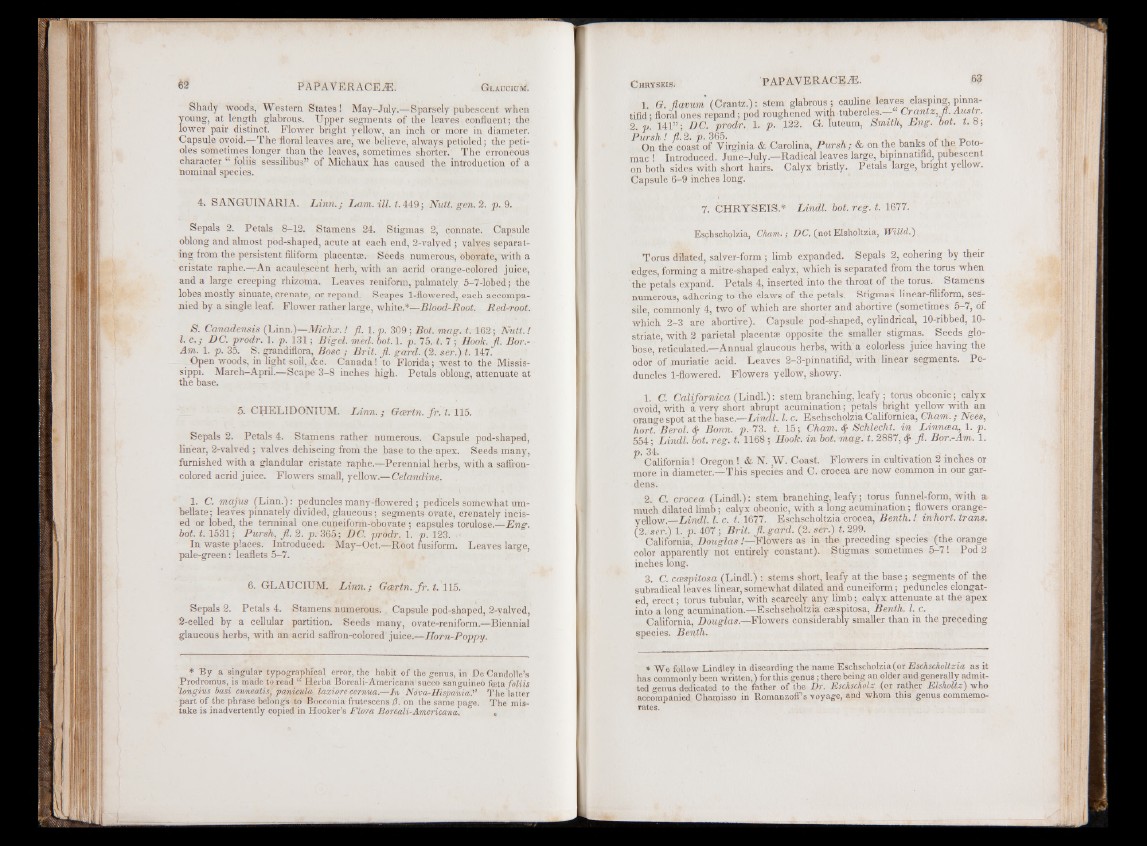
Shady woods, Western States! May-July.—Sparsely pubescent when
young, at length glabrous. Upper segments of the leaves confluent; the
lower pair distinct. Flower bright yellow, an inch or more in diameter.
Capsule ovoid.—The floral leaves are, we believe, always petioled; the petioles
sometimes longer than the leaves, sometimes shorter.' The erroneous
character “ foliis sessilibus” of Michaux has caused the introduction of a
nominal species.
4. SANGUINARIA. L in n .; Lam. ill. t .449; Nutt. gen. 2. p. 9.
Sepals 2. Petals 8-12. Stamens 24. Stigmas 2, connate. Capsule
oblong and almost pod-shaped, acute at each end, 2-valyed ; valves separating
from the persistent filiform placentae. Seeds numerous, obovate, with a
cristate raphe.—An acaulescent herb, with an acrid orange-colored juice,
and a large creeping rhizoma. Leaves reniform, palmately 5- 7-lobed; the
lobes mostly sinuate, crenate, or repand. Scapes 1-flowered, each accompanied
by a single leaf. Flower rather large, white.*—Blood-Root. Red-root.
S. Canadensis (Linn.)—Michx.! fl. l.p . 309; Bot. mag. t. 162; Nutt.!
1. c.; DC. prodr. 1. p. 131; Bigel. med. bot. 1. p. 75. t. 7 ; Hook. fl. Bor-
Am. 1. p. 35. S. grandiflora, Bose ; Brit. fl. gard. (2. ser.) t. 147.
7 Open woods, in light soil, &c. Canada! to Florida; west to the Mississippi.
March-April.—Scape 3-8 inches high. Petals oblong, attenuate at
the base.
5. CHELIDONIUM. L in n .; Gcertn. fr . t. 115.
Sepals 2. Petals 4. Stamens rather numerous. Capsule pod-shaped,
linear, 2-valved ; valves dehiscing from the base to the apex. Seeds many,
furnished with a glandular cristate raphe.—Perennial herbs, with a saffion-
colored acrid juice. Flowers small, yellow.—Celandine.
1. C. majus (Linn.): peduncles many-flowered; pedicels somewhat umbellate;
leaves pinnately divided, glaucous; segments ovate, crenately incised
or lobed, the terminal one euneiform-obovate ; capsules torulose.—Eng.
bot. t. 1531; Pursh, fl. 2. p. 365; DC. prodr. 1. p. 123.
In waste places. Introduced. May-Oct.—Root fusiform. Leaves large,
pale-green: leaflets 5-7.
6. GLAUCIUM. Lin n .; Gcertn. f r . t . 115.
Sepals 2. Petals 4. Stamens numerous. Capsule pod-shaped, 2-valved,
2-celled by a cellular partition. Seeds many, ovate-reniform.—Biennial
glaucous herbs, with an acrid saffron-colored juice.—Horn-Poppy.
* By a singular typographical error, the habit of the genus, in De Candolle’s
Prodromus, is made to read “ Herba Boreali-Americana1 succo sanguined feeta foliis
longius ban enneatis, panicula laxiore cernua.—In Ndva-Hispania.'1’ The latter
part of the phrase belongs to Bocconia frutescens 0. on the same page. The mistake
is inadvertently copied in Hooker’s Flora Boreali-Americana. ,
1. G. flavum (Crantz.): stem glabrous; cauline leaves clasping, pinna-
tifid; floral ones repand; pod roughened with tubercles.— Crantz, fl.Au str.
2. p. 141” ; DC. prodr. 1. p. 122. G. luteum, Smith, Eng. bot. t. 8 ;
Pursh! fl. 2. p. 365. 1 , . . . . „
On the coast of Virginia & Carolina, Pursh; & on the banks of the Potomac
! Introduced. June-July.—Radical leaves large, bipinnatmd, pubescent
on both sides with short hairs. Calyx bristly. Petals large, bright yellow.
Capsule 6-9 inches long.
7. CHRYSEIS * Lindl. bot. reg. t. 1677.
Eschscholzia, Cham.; DC. (notElsholtzia, IVilld.) (
Torus dilated, salver-form; limb expanded. Sepals 2, cohering by their
edges, forming a mitre-shaped calyx, which is separated from the torus when
the petals expand. Petals 4, inserted into the throat of the torus. Stamens
numerous, adhering1 to the claws of the petals. Stigmas linear-filiform, sessile,
commonly 4, two of which are shorter and abortive (sometimes 5-7, of
which 2-3 are abortive). Capsule pod-shaped, cylindrical, 10-ribbed, 10-
striate, with 2 parietal placentae opposite the smaller stigmas. Seeds globose,
reticulated.—Annual glaucous herbs, with a colorless juice having the
odor of muriatic acid. Leaves 2-3-pinnatifid, with linear segments. Peduncles
1-flowered. Flowers yellow, showy.
1. C. Californica (Lindl.): stem branching, leafy ; torus obconic; calyx
ovoid, with a very short abrupt acumination; petals bright yellow with an
orange spot at the base.—Lindl. 1. c. Eschscholzia Californica, Cham.; Nees,
hort. Berol. f Bonn. p. 73. t. 15; Cham. <$■ Schlecht. in Linncea, 1. p.
554; Lindl. bot. reg. t. 1168; Hook, in bot. mag. t. 2887, £ fl. Bor.-Am. 1.
* California! Oregon ! & N. W. Coast. Flowers in cultivation 2 inches or
more in diameter.—This species and C. crocea are now common in our gardens.
2. C. crocea (Lindl.) : stem branching, leafy; torus funnel-form, with a
much dilated limb; calyx obconic, with a long acumination; flowers orange-
yellow.—Lindl. 1. c. t. 1677. Eschscholtzia crocea, Benth.! inhort. trans.
(2. ser.) 1. p. 407 ; Brit. fl. gard. (2. ser.) t, 299.
California, Douglas /—Flowers as in the preceding species (the orange
color apparently not entirely constant). Stigmas sometimes 5-7! Pod 2
inches long.
3. C. ccespitosa (Lindl.) : stems short, leafy at the base; segments of the
subradical leaves linear, somewhat dilated and cuneiform; peduncles elongated
erect; torus tubular, with scarcely any limb; calyx attenuate at the apex
into a long acumination.—Eschscholtzia caespitosa, Benth. 1. c.
California, Douglas.—Flowers considerably smaller than in the preceding
species. Benth.
* We follow Lindley in discarding the name Eschscholzia (or Eschscholtzia as it
has commonly been written,) for this genus; there being an older and generally admitted
genus dedicated to the father of the Dr. Eschscholz (or rather Elsholtz) who
accompanied Chamisso in Romanzoff’s voyage, and whom this genus commemo-
rates.